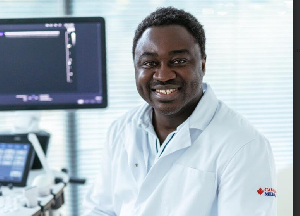Accra, April 22, GNA - The National HIV/AIDS Prevalence Rate increased from 3.4 per cent to 3.6 percent in 2003. "It means that there was a slow rise, an indication that Ghana would not reach the East African levels for sometime to come," Dr Nii Akwei Addo, Programme Manager of the National AIDS Control Programme (NACP) has said. Dr Addo was presenting the sentinel surveillance report on HIV/AIDS Prevalence Rate in the country in the year 2003 after a nationwide survey by NACP.
He, however, stated that the prevalence rate among those between 45 years to 49 years had risen dramatically while that among age 15 years and 24 had dropped sharply and had been declining since they year 2001. There seem a to be a shift from the lower to upper age groups. Dr Addo said HIV Prevalence Rate increased from 2.3 per cent in 2000 to 3.6 per cent in 2003, an increase of over 50 per cent in three years while the figures in two areas Takoradi and Eikwe, both in the Western Region, stabilised and there was an obvious decline in Ho but not in Hohoe in the Volta Region.
The trend according to Dr Addo confirmed a steady rise since 2000 but the increase from 2002 was relatively lower than in previous years. On spatial distribution, the disease was most prevalent in the Southern Sector followed by the Middle and the Northern in that order. The Eastern and Central Regions had a prevalence rate of above 5 per cent while the Upper West Region had the lowest rate. The survey, which was conducted on anonymity basis, removed personal identifiers of the respondents and also all sexually transmitted infections (STI) diagnosed during the survey period were included in the survey.
Dr Addo expressed concern over the dramatic rise in the rate in Cape Coast and Fanteakwa and asked stakeholders to work hard in the campaign against the disease, but was also surprised about a sharp decline from Koforidua from over 8 per cent to a little over two per cent.
However there has been a high infection rate of syphilis between the ages of 15 to 19 years especially in Cape Coast and Eikwe, which contributed nearly seventy per cent of syphilis infections in the survey.
Dr Addo noted that the result of the survey would be a model for estimates and projections of infections in the general population to provide a firm basis for planning and forecasting health needs including provision of anti retroviral drugs to support programmes.
Professor Sakyi Amoa, Executive Director of the Ghana AIDS Commission, who chaired the function, noted that though there was a decline in the prevalence rate of the youth there was the need to work harder to change the worrying trend of high infections in the elderly. 22 April 04
General News of Thursday, 22 April 2004
Source: GNA
















